
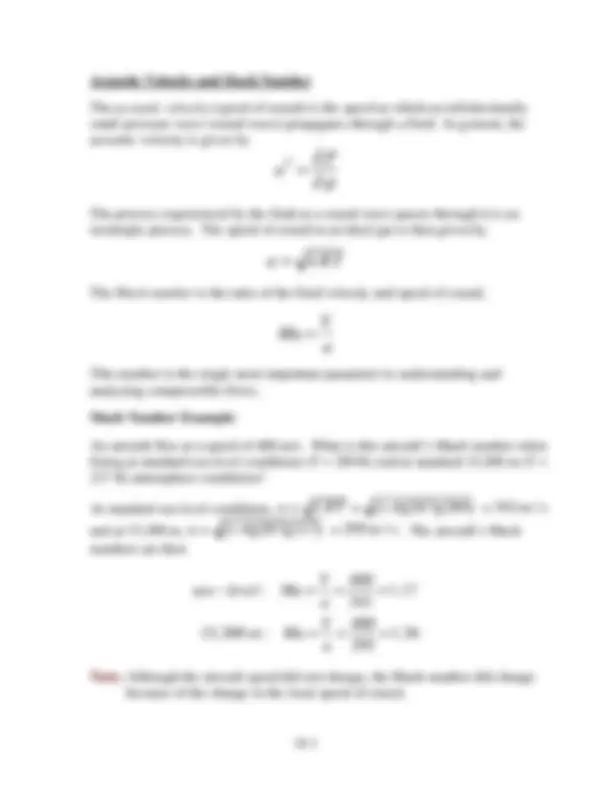
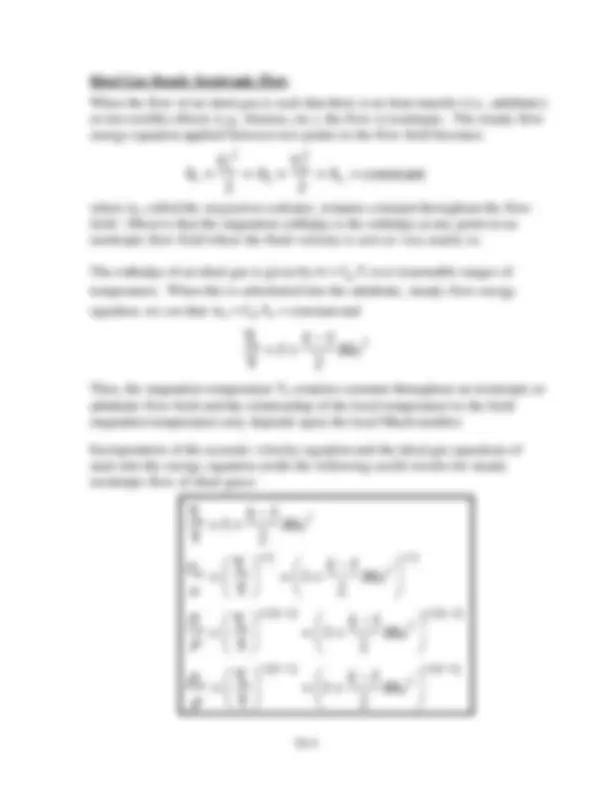
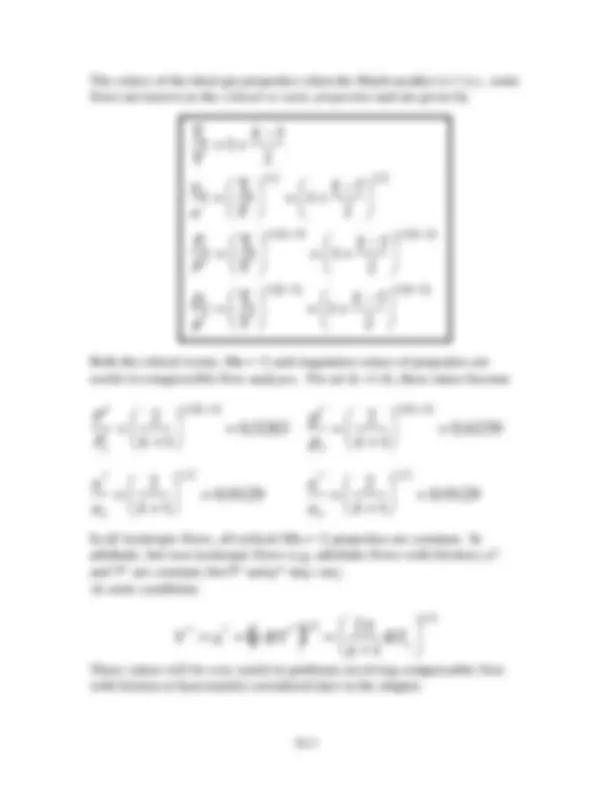
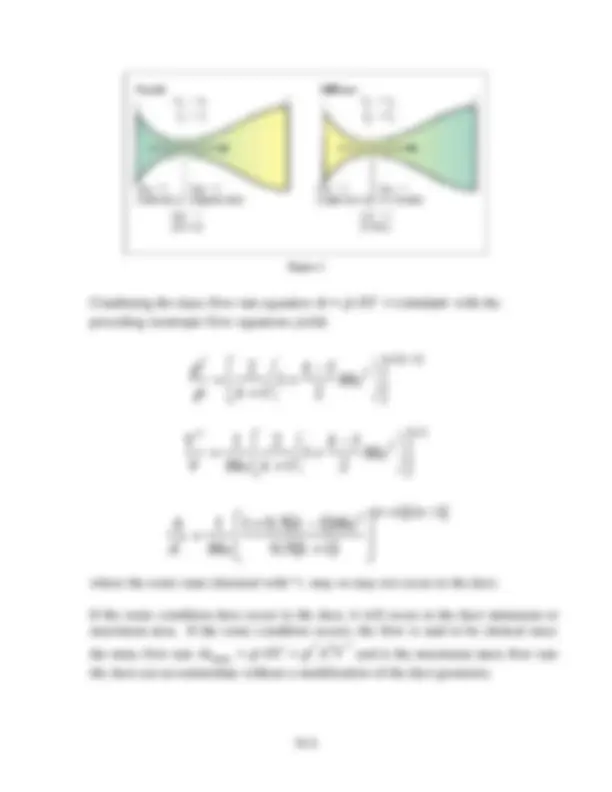
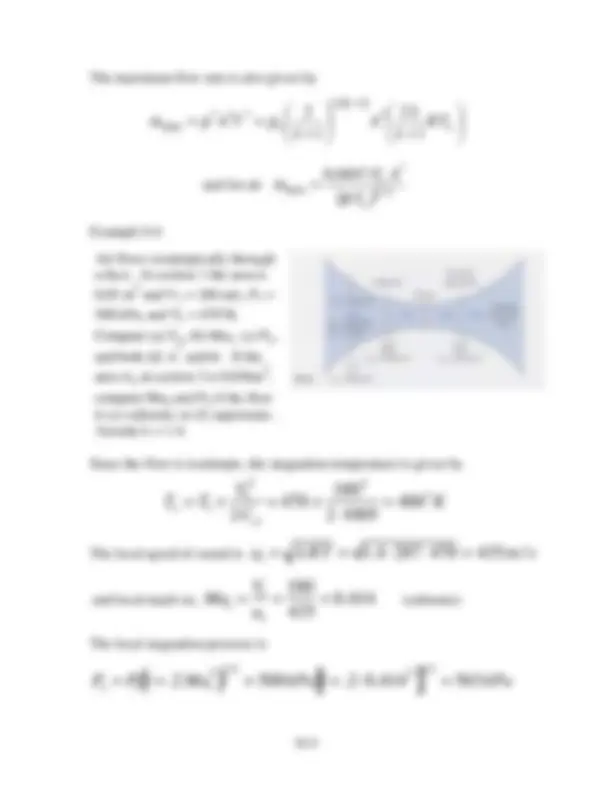
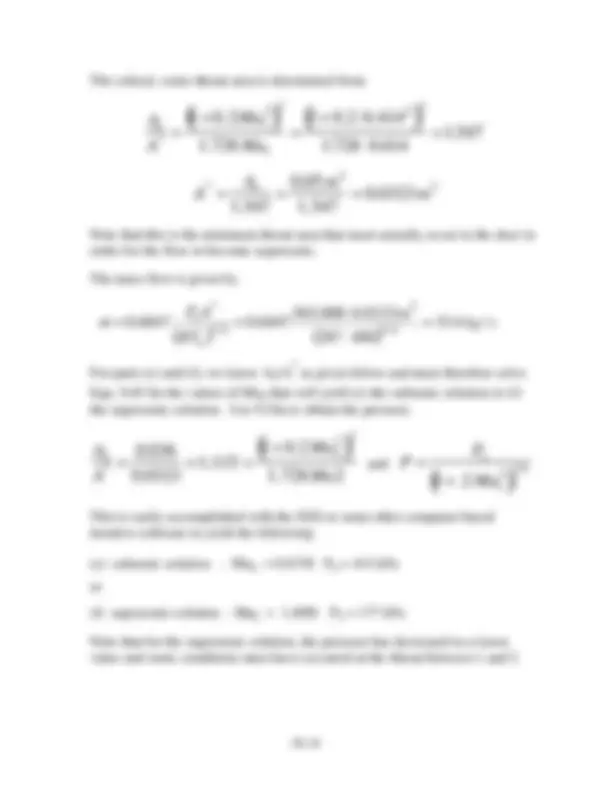
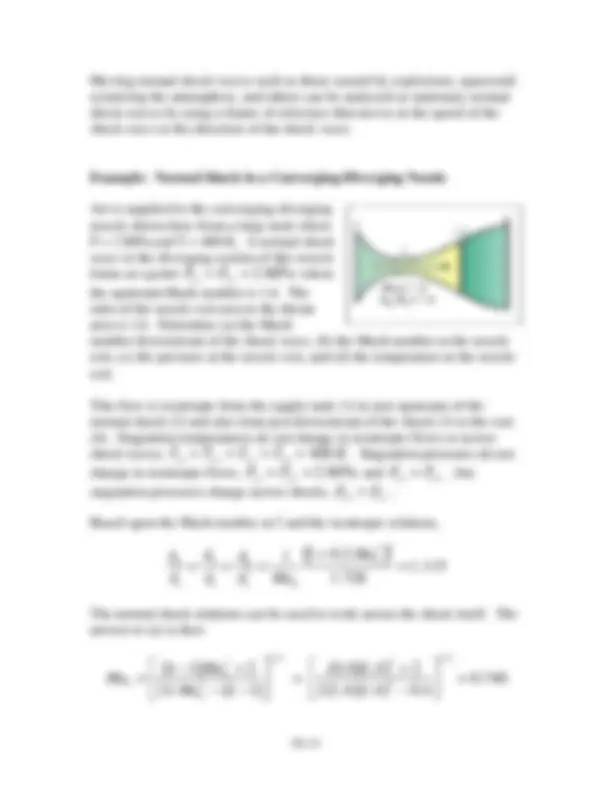
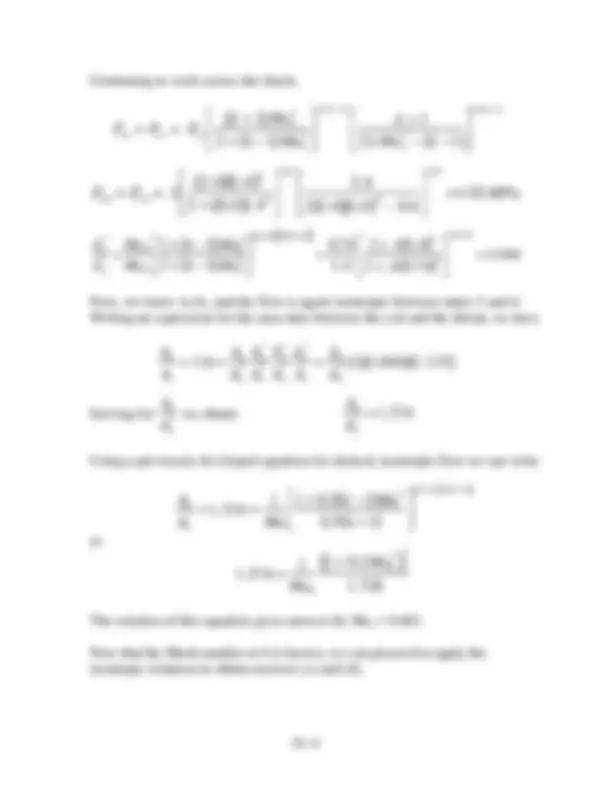
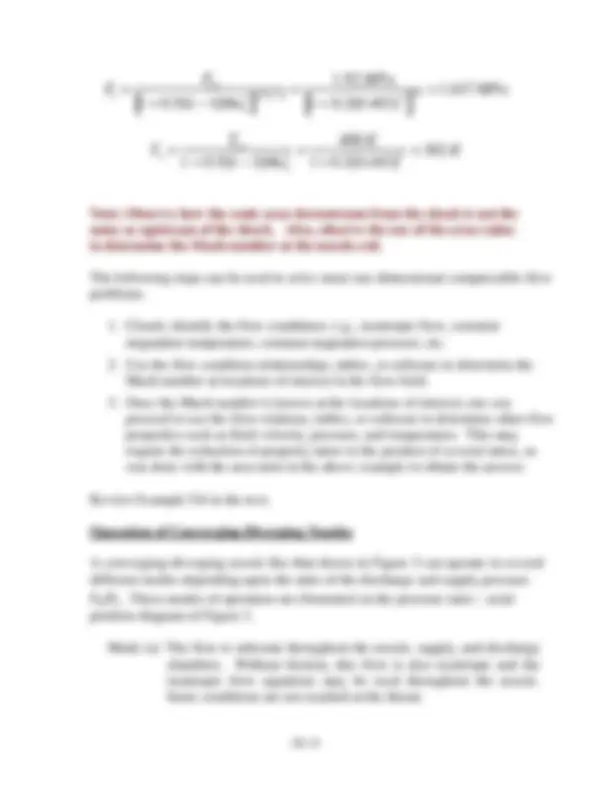
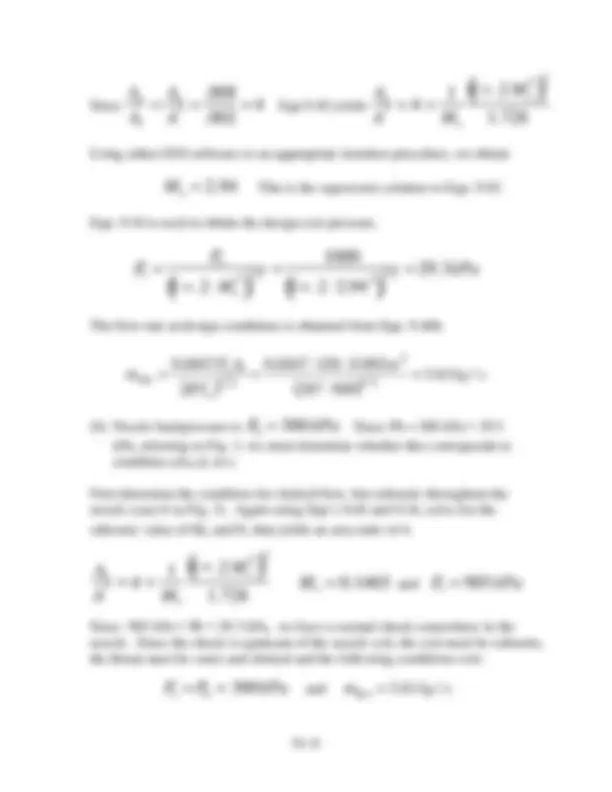
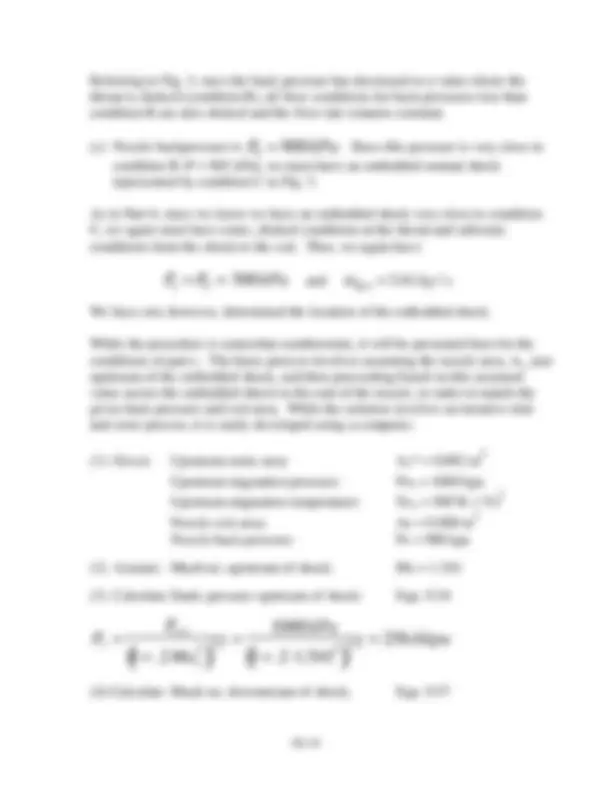
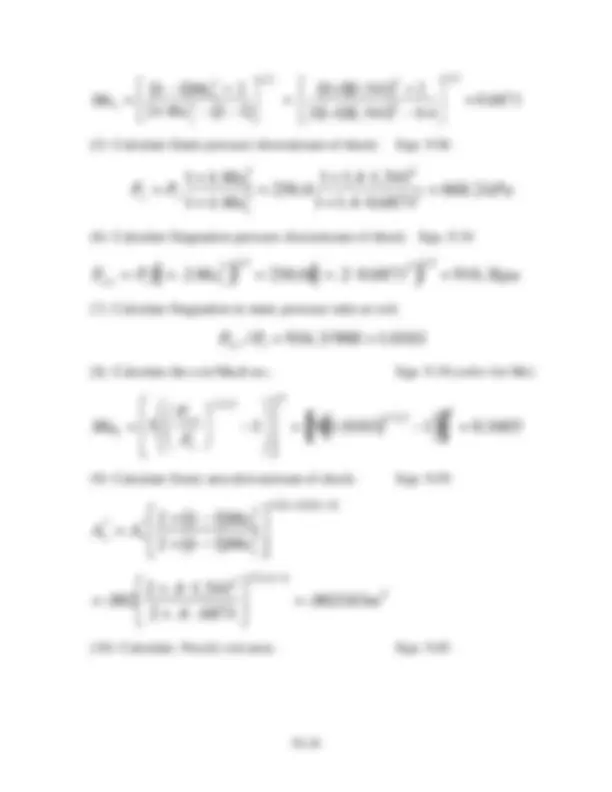
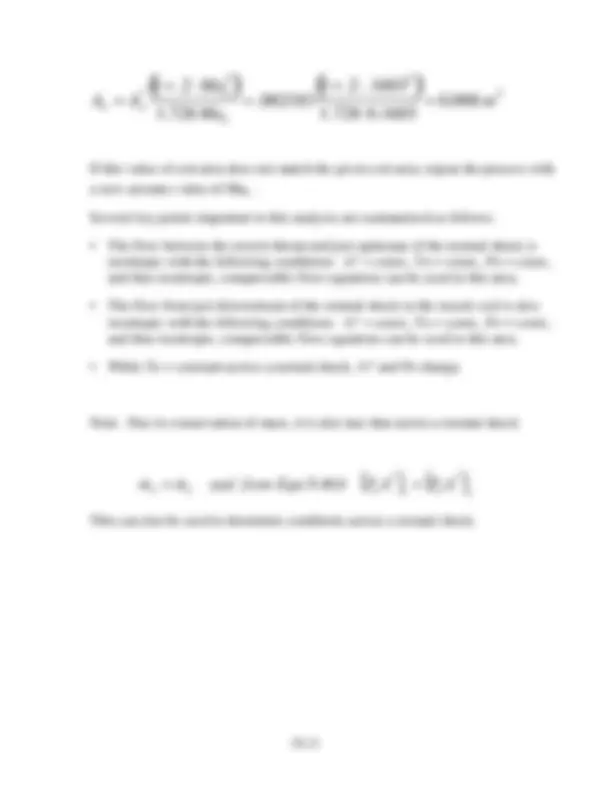
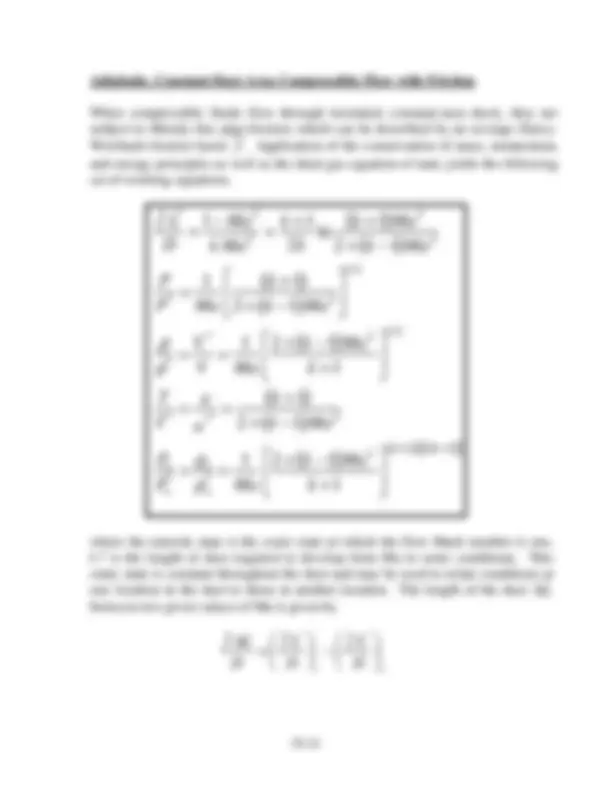
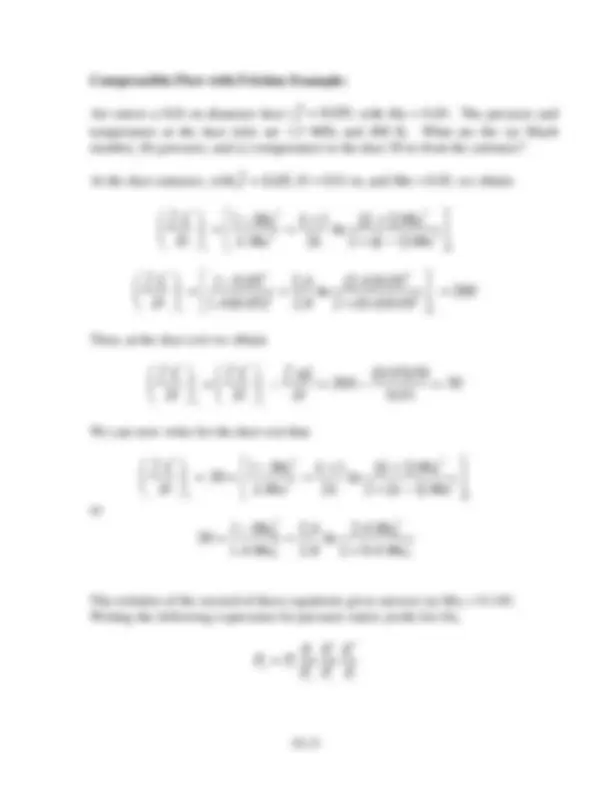
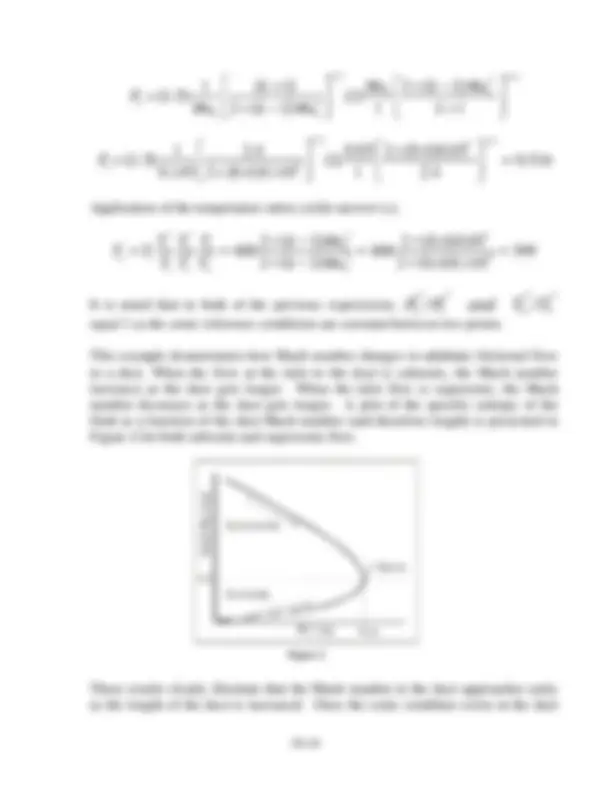

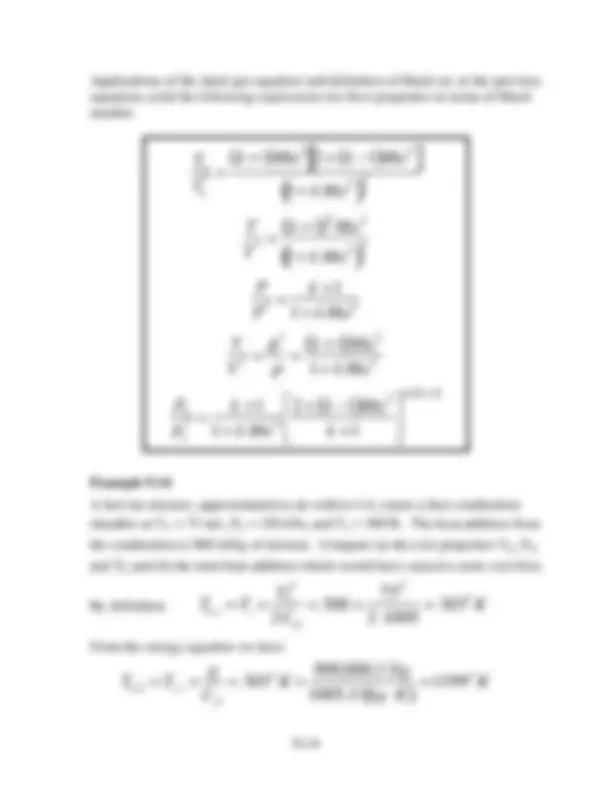
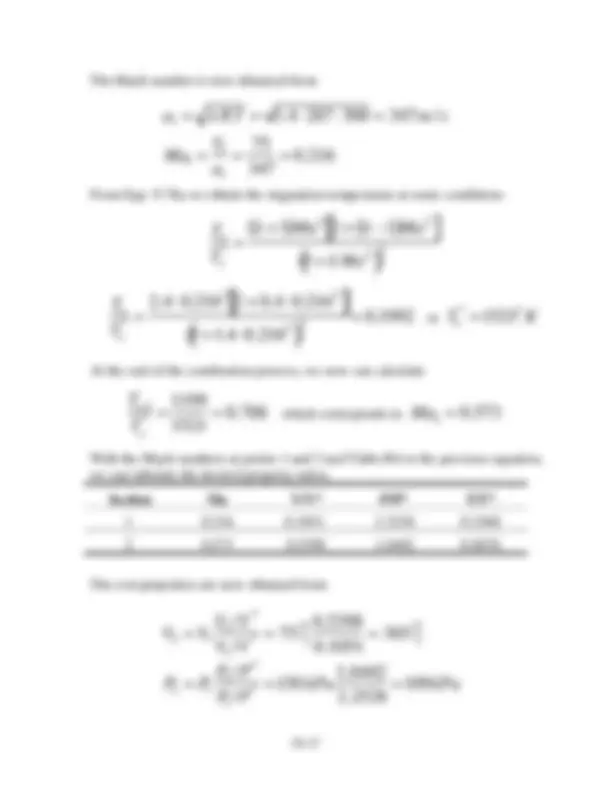
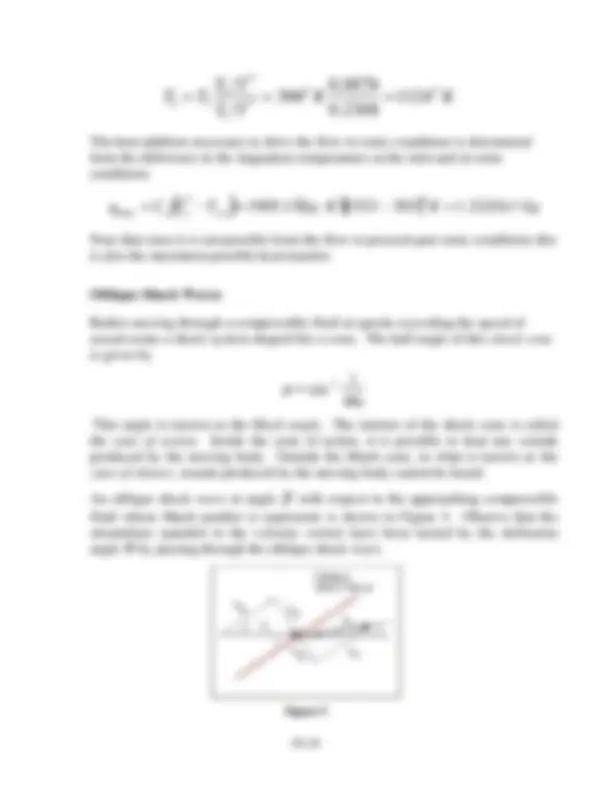
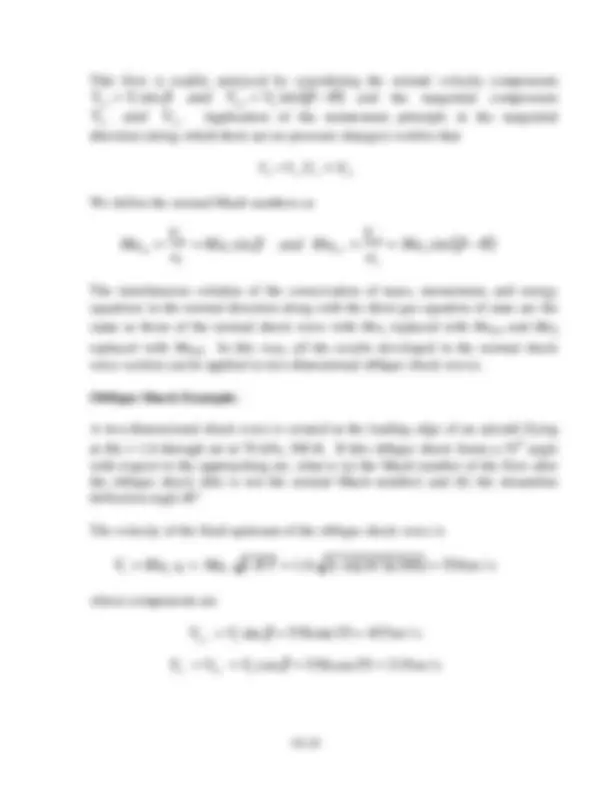
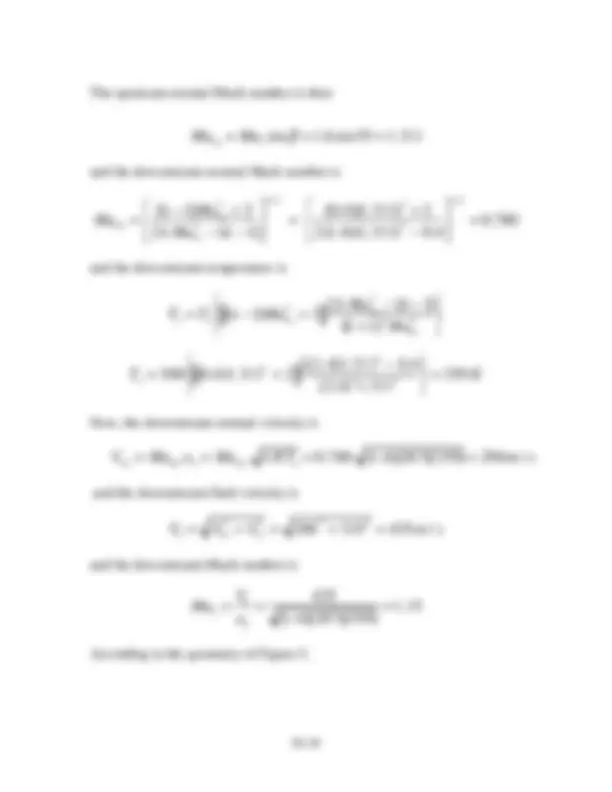
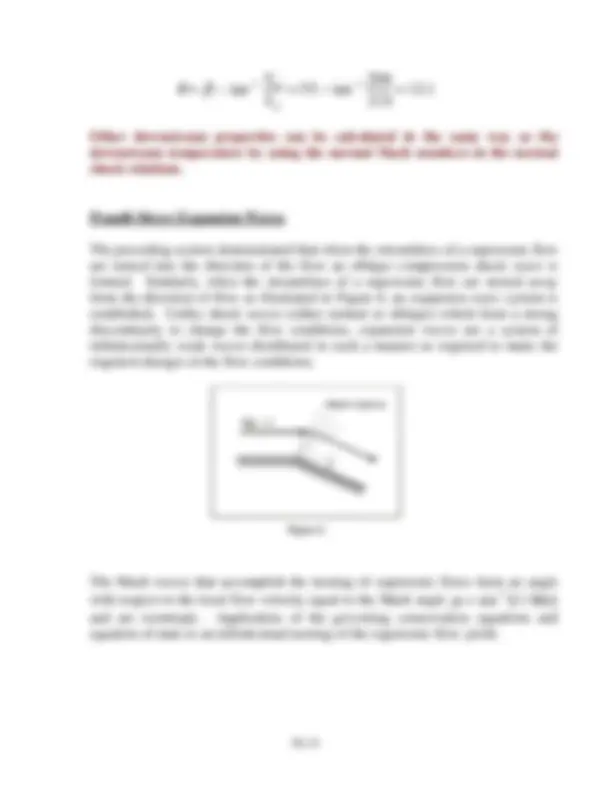
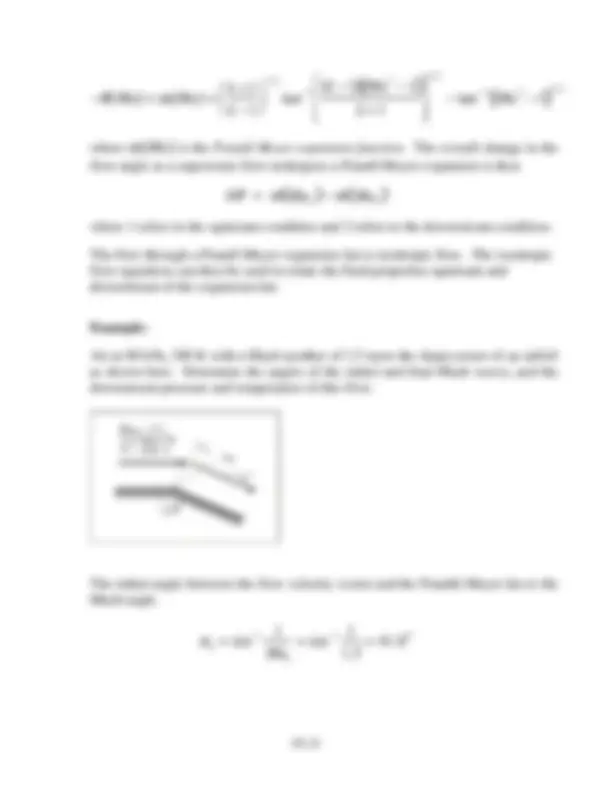
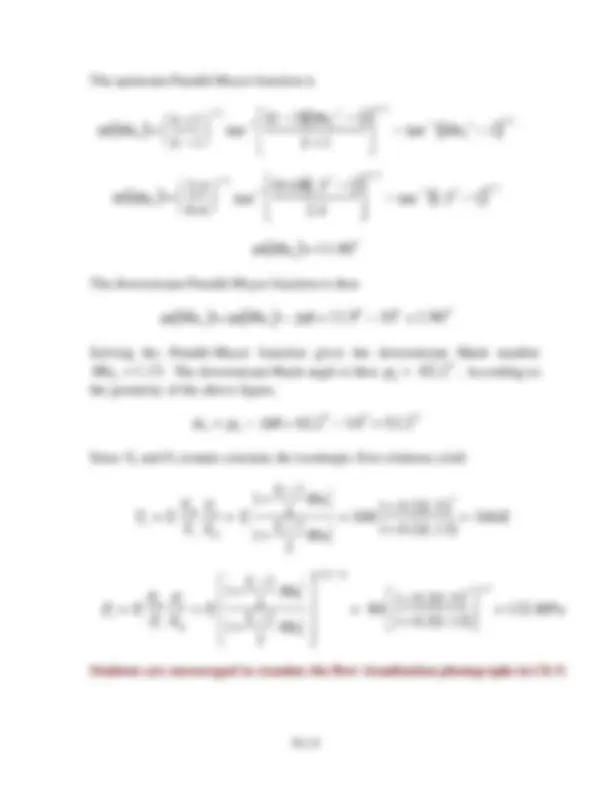


Study with the several resources on Docsity

Earn points by helping other students or get them with a premium plan


Prepare for your exams
Study with the several resources on Docsity

Earn points to download
Earn points by helping other students or get them with a premium plan
Community
Ask the community for help and clear up your study doubts
Discover the best universities in your country according to Docsity users
Free resources
Download our free guides on studying techniques, anxiety management strategies, and thesis advice from Docsity tutors
The effects of choking and shock waves in compressible flows, including equations for ideal gas properties, isentropic flow relations, and normal shock relations. It also covers the analysis of moving normal shock waves and the calculation of flow properties in terms of Mach number.
Typology: Exercises
1 / 33

This page cannot be seen from the preview
Don't miss anything!


























IX. COMPRESSIBLE FLOW
Compressible flow is the study of fluids flowing at speeds comparable to the local speed of sound. This occurs when fluid speeds are about 30% or more of the local acoustic velocity. Then, the fluid density no longer remains constant throughout the flow field. This typically does not occur with fluids but can easily occur in flowing gases.
Two important and distinctive effects that occur in compressible flows are (1) choking where the flow is limited by the sonic condition that occurs when the flow velocity becomes equal to the local acoustic velocity and (2) shock waves that introduce discontinuities in the fluid properties and are highly irreversible.
Since the density of the fluid is no longer constant in compressible flows, there are now four dependent variables to be determined throughout the flow field. These are pressure, temperature, density, and flow velocity. Two new variables, temperature and density, have been introduced and two additional equations are required for a complete solution. These are the energy equation and the fluid equation of state. These must be solved simultaneously with the continuity and momentum equations to determine all the flow field variables.
Equations of State and Ideal Gas Properties:
Two equations of state are used to analyze compressible flows: the ideal gas equation of state and the isentropic flow equation of state. The first of these describe gases at low pressure (relative to the gas critical pressure) and high temperature (relative to the gas critical temperature). The second applies to ideal gases experiencing isentropic (adiabatic and frictionless) flow.
The ideal gas equation of state is
ρ = (^) R TP
In this equation, R is the gas constant, and P and T are the absolute pressure and absolute temperature respectively. Air is the most commonly incurred compressible flow gas and its gas constant is Rair = 1716 ft 2 /(s 2 - o^ R) = 287 m^2 /(s 2 - K).
Two additional useful ideal gas properties are the constant volume and constant pressure specific heats defined as
C (^) v = d^ u d T
and C (^) p = d^ h d T
where u is the specific internal energy and h is the specific enthalpy. These two properties are treated as constants when analyzing elemental compressible flows. Commonly used values of the specific heats of air are: Cv= 4293 ft 2 /(s^2 - o^ R) = 718 m^2 /(s 2 -K) and Cp= 6009 ft 2 /(s 2 - o^ R) = 1005 m^2 /(s 2 -K). Additional specific heat relationships are
R = C (^) p − C (^) v and k =
C (^) p C (^) v
The specific heat ratio k for air is 1.4.
When undergoing an isentropic process (constant entropy process), ideal gases obey the isentropic process equation of state:
P ρ k^
= constant
Combining this equation of state with the ideal gas equation of state and applying the result to two different locations in a compressible flow field yields
P 2 P 1
k / ( k^ − 1 ) = ρ^2 ρ 1
k
Note: The above equations may be applied to any ideal gas as it undergoes an isentropic process.
Ideal Gas Steady Isentropic Flow When the flow of an ideal gas is such that there is no heat transfer (i.e., adiabatic) or irreversible effects (e.g., friction, etc.), the flow is isentropic. The steady-flow energy equation applied between two points in the flow field becomes
h 1 + V^1
2 2
= h 2 + V^2
2 2
= ho = constant
where h 0 , called the stagnation enthalpy , remains constant throughout the flow field. Observe that the stagnation enthalpy is the enthalpy at any point in an isentropic flow field where the fluid velocity is zero or very nearly so.
The enthalpy of an ideal gas is given by h = Cp T over reasonable ranges of temperature. When this is substituted into the adiabatic, steady-flow energy equation, we see that h (^) o = C (^) p To = constant and
To T
= 1 + k^ −^1 2
Ma^2
Thus, the stagnation temperature To remains constant throughout an isentropic or adiabatic flow field and the relationship of the local temperature to the field stagnation temperature only depends upon the local Mach number.
Incorporation of the acoustic velocity equation and the ideal gas equations of state into the energy equation yields the following useful results for steady isentropic flow of ideal gases.
To T
= 1 + k^ −^1 2
Ma^2
ao a
= To T
1/ = 1 + k^ −^1 2
Ma 2 1/
Po P
= To T
k / ( k − 1 ) = 1 + k^ −^1 2
Ma 2 k /( k − 1 )
ρ o ρ
= To T
1/( k − (^1) ) = 1 + k^ −^1 2
Ma 2 1/ (^) ( k − (^1) )
The values of the ideal gas properties when the Mach number is 1 (i.e., sonic flow) are known as the critical or sonic properties and are given by
To T*^
= 1 + k^ −^1 2 ao a *^
= To T*
1/ = 1 + k^ −^1 2
1/
Po P *^
= To T*
k / ( k − 1 ) = 1 + k^ −^1 2
k / ( k − 1 )
ρ o ρ*^
= To T*
1/ (^) ( k − (^1) ) = 1 + k^ −^1 2
1/ (^) ( k − (^1) )
Both the critical (sonic, Ma = 1) and stagnation values of properties are useful in compressible flow analyses. For air (k =1.4), these ratios become
P * Po
k + 1
k / ( k − 1 ) = 0.5283^ ρ
ρ o
k + 1
1/ ( k − 1 ) = 0.
a * ao
k + 1
1/ = 0.9129 a
ao
k + 1
1/ = 0.
In all isentropic flows, all critical (Ma = 1) properties are constant. In adiabatic, but non-isentropic flows (e.g. adiabatic flows with friction), a* and T* are constant, but P* and ρ* may vary. At sonic conditions
1/2 = 2 k k +^1
RTo 1/
These values will be very useful in problems involving compressible flow with friction or heat transfer considered later in the chapter.
V = Ma k R T = 0.469 1.4 ⋅ 287 ⋅ 383 = 184 m / s
Solving Compressible Flow Problems
Compressible flow problems come in a variety of forms, but the majority of them can be solved as follows:
Most compressible flow equations are expressed in terms of the Mach number. You can solve these equations explicitly by rearranging the equation, by using tables, or by programming them with spreadsheet or EES software.
Isentropic Flow with Area Changes
All flows must satisfy the continuity and momentum relations as well as the energy and state equations. Application of the continuity and momentum equations to a differential flow (see textbook for derivation) yields:
d V V
= 1 Ma^2 −^1
d A A
This result reveals that when Ma < 1 (subsonic flow), Ma - 1 < 0 and velocity changes are the opposite of area changes. That is, increases in the fluid velocity require that the area decrease in the direction of the flow. For supersonic flow ( Ma
1), Ma - 1 > 0 and the area must increase in the direction of the flow to cause an increase in the velocity. Changes in the fluid velocity dV can only be finite in sonic flows ( Ma = 1) when dA = 0. The effect of the geometry upon velocity, Mach number, and pressure is illustrated in Figure 1 below.
Figure 1
Combining the mass flow rate equation m! = ρ AV =constant with the preceding isentropic flow equations yields
ρ* ρ
k + 1
1 + k^ −^1 2
Ma 2 ^
1/ ( k − 1 )
Ma
k + 1
1 + k^ −^1 2
Ma 2 ^
1/
Ma
( k + 1 )/ 2[ ( k − 1 )]
where the sonic state (denoted with *) may or may not occur in the duct.
If the sonic condition does occur in the duct, it will occur at the duct minimum or maximum area. If the sonic condition occurs, the flow is said to be choked since the mass flow rate m!^ max =ρ AV = ρ* A * V *and is the maximum mass flow rate the duct can accommodate without a modification of the duct geometry.
The critical, sonic-throat area is determined from
A 1 A *^
3
1.728 Ma 1
3
1.728⋅ 0.
= 0.05^ m
2
= 0.0323 m^2
Note that this is the minimum throat area that must actually occur in the duct in order for the flow to become supersonic.
The mass flow is given by
m kg s RT
m PA o
o (^) 33. 4 / 287 486
2 1 / 2
= ⋅
! = = ⋅
For parts (e) and (f), we know A2/A*^ as given below and must therefore solve Eqn. 9.45 for the values of Ma 2 that will yield (e) the subsonic solution or (f) the supersonic solution. Use 9.28a to obtain the pressure.
A 2 A *^
3
1.728 Ma 2
and P = Po
This is easily accomplished with the EES or some other computer based iterative software to yield the following:
(e) subsonic solution - Ma 2 = 0.6758 P 2 = 415 kPa or (f) supersonic solution - Ma 2 = 1.4001 P 2 = 177 kPa
Note that for the supersonic solution, the pressure has decreased to a lower value and sonic conditions must have occurred at the throat between 1 and 2.
Normal Shock Waves
Under the appropriate conditions, very thin, highly irreversible discontinuities can occur in otherwise isentropic compressible flows. These discontinuities are known as shock waves which when they are perpendicular to the flow velocity vector are called normal shock waves.
A normal shock wave in a one-dimensional flow channel is illustrated in Figure 2.
Figure 2
Application of the second law of thermodynamics to the thin, adiabatic normal shock wave reveals that normal shock waves can only cause a sharp rise in the gas pressure and must be supersonic upstream and subsonic downstream of the normal shock. Rarefaction waves that result in a decrease in pressure and increase in Mach number are impossible according to the second law.
Application of the conservation of mass, momentum, and energy equations along with the ideal gas equation of state to a thin, adiabatic control volume surrounding a normal shock wave yields the results shown in the following table.
It is noted that in many compressible flow problems with normal shocks, the location of the shock is unknown. From the equations shown below, this is most readily specified by finding the mach no upstream of the shock, Ma1. However, for most problems this requires an iterative solution of one of the following equations, depending on the given information.
Moving normal shock waves such as those caused by explosions, spacecraft reentering the atmosphere, and others can be analyzed as stationary normal shock waves by using a frame of reference that moves at the speed of the shock wave in the direction of the shock wave.
Example: Normal Shock in a Converging-Diverging Nozzle
Air is supplied to the converging-diverging nozzle shown here from a large tank where P = 2 MPa and T = 400 K. A normal shock wave in the diverging section of this nozzle forms at a point Po 1 = Po 2 = 2 MPa where the upstream Mach number is 1.4. The ratio of the nozzle exit area to the throat area is 1.6. Determine (a) the Mach number downstream of the shock wave, (b) the Mach number at the nozzle exit, (c) the pressure at the nozzle exit, and (d) the temperature at the nozzle exit.
This flow is isentropic from the supply tank (1) to just upstream of the normal shock (2) and also from just downstream of the shock (3) to the exit (4). Stagnation temperatures do not change in isentropic flows or across shock waves, To 1 = To 2 = To 3 = To 4 = 400 K. Stagnation pressures do not change in isentropic flows, Po 1 = Po 2 = 2 MPa and Po 3 = Po 4 , but stagnation pressures change across shocks, (^) Po 2 > (^) Po 3.
Based upon the Mach number at 2 and the isentropic relations,
A 2 At^ =^
A 3 At^ =^
A 2 At^ *^ =^
1 Ma 2
(^1 +^ 0.2^ Ma 22 )^3 1.728 =^ 1.
The normal shock relations can be used to work across the shock itself. The answer to (a) is then
Ma 3 = ( k^^ −^1 ) Ma^2
(^2) + 2 2 k Ma 22 − ( k − 1 )
^
1/ 2 = (0.4^ )(^ 1.4^ )
(^2) + 2 2 1.4( ) (1.4 )^2 − 0.
^
1/ 2 = 0.
Continuing to work across the shock,
2 2 + ( k − 1 ) Ma 22
^
k / ( k − 1 ) k + 1 2 k Ma 22 − ( k − 1 )
^
1/ ( k − 1 )
2
3.5 2.
= 1.92 MPa
A 3 * A 2 *^ =^
Ma 3 Ma 2
2 + ( k − 1 ) Ma 22 2 + ( k − 1 ) Ma 32
^
( k + 1 )/ 2[ ( k − 1 )] = 0.741.4^2 +^ .4 1.4(^ )
2 2 + .4 0.74( )^2
2.4 /. = 1.
Now, we know A 4 / A t , and the flow is again isentropic between states 3 and 4. Writing an expression for the area ratio between the exit and the throat, we have
A 4 At^ =^ 1.6^ =^
A 4 A 4 *
A 4 * A 3 *
A 3 * A 2 *
A 2 * At^ =^
A 4 A 4 *^ ( )^1 (^ 1.044^ )(^ 1.115^ )
Solving for (^) AA^4 4 *^
we obtain (^) AA^4 4 *^
= 1.
Using a previously developed equation for choked, isentropic flow we can write
A 4 A 4 *^
= (^) 1.374 = 1 Ma
1 +^ 0.5( k^ − 1 ) Ma^2 0.5 ( k^ +^1 )
^
(^ k^ +^1 )/ 2[ ( k^ −^1 )]
or
1.374 = (^) Ma^1 4
(^1 +^ 0.2 Ma 42 )^3
The solution of this equation gives answer (b) Ma 4 = 0.483.
Now that the Mach number at 4 is known, we can proceed to apply the isentropic relations to obtain answers (c) and (d).
Figure 3
Mode (b) The flow is still subsonic and isentropic throughout the nozzle and chambers. The Mach number at the nozzle throat is now unity. At the throat, the flow is sonic, the throat is choked, and the mass flow rate through the nozzle has reached its upper limit for the given geometry and Po, To. Further reductions in the discharge tank pressure will not increase the mass flow rate any further.
Mode (c) A shock wave has now formed in the diverging section of the nozzle. The flow is subsonic before the throat, same as mode (b), the throat is choked, same as mode (b), and the flow is supersonic and accelerating between the throat and just upstream of the shock. The flow is isentropic between the supply tank and just upstream of the shock. The flow downstream of the shock is subsonic and decelerating. The flow is also isentropic downstream of the shock to the discharge tank. The flow is not isentropic across the shock. Isentropic flow methods can be applied upstream and downstream of the shock while normal shock methods are used to relate conditions upstream to those downstream of the shock.
Mode (d) The normal shock is now located at the plane of the nozzle exit. Isentropic flow now exists throughout the nozzle up to the shock. The flow at the nozzle exit is supersonic upstream of the shock and subsonic downstream of the shock. The flow adjusts to flow conditions in the discharge tank, not the nozzle. Isentropic flow methods can be applied throughout the nozzle. Mode (e) A series of two-dimensional shocks are established in the discharge tank downstream of the nozzle. These shocks serve to decelerate the flow. The flow is isentropic throughout the nozzle, same as mode (d). Mode (f) The pressure in the discharge tank equals the pressure predicted by the supersonic solution of the nozzle isentropic flow equations. The pressure ratio is known as the supersonic design pressure ratio. Flow is isentropic everywhere in the nozzle, same as mode (d) and (e), and in the discharge tank. Mode (g) A series of two-dimensional shocks are established in the discharge tank downstream of the nozzle. These shocks serve to decelerate the flow. The flow is isentropic throughout the nozzle, same as modes (d), (e), and (f).
Example 9. A converging-diverging nozzle has the following values: At = .002 m^2 , Ae = .008 m^2 , Po = 1000 kPa, To = 500˚K. Find: Pe and mass flow rate for (a) supersonic design conditions (b) Pb = 300 kPa, and (c) Pb = 900 kPa. k = 1.
(a) For supersonic design conditions, the flow will be isentropic throughout with supersonic flow from the throat to the exit. Stagnation pressure and temperature will be constant. Conditions at the throat will be sonic and the flow will be choked.
Referring to Fig. 3, once the back pressure has decreased to a value where the throat is choked (condition B), all flow conditions for back pressures less than condition B are also choked and the flow rate remains constant.
(c) Nozzle backpressure is (^) Pb = 900 kPa. Since this pressure is very close to condition B (P = 985 kPa), we must have an embedded normal shock represented by condition C in Fig. 3.
As in Part b, since we know we have an embedded shock very close to condition C, we again must have sonic, choked conditions at the throat and subsonic conditions from the shock to the exit. Thus, we again have
Pe = Pb = 300 kPa and m! des = 3. 61 kg / s
We have not, however, determined the location of the embedded shock.
While the procedure is somewhat cumbersome, it will be presented here for the conditions of part c. The basic process involves assuming the nozzle area, Ax, just upstream of the embedded shock, and then proceeding based on this assumed value across the embedded shock to the end of the nozzle, in order to match the given back pressure and exit area. While the solution involves an iterative trial and error process, it is easily developed using a computer.
(1) Given: Upstream sonic area: A (^) 1* = 0.002 m^2 Upstream stagnation pressure: Po 1 = 1000 kpa Upstream stagnation temperature: To 1 = 500˚K = To^2 Nozzle exit area; Ae = 0.008 m^2 Nozzle back pressure: Pe = 900 kpa
(2) Assume: Mach no. upstream of shock: Mx = 1.
(3) Calculate: Static pressure upstream of shock: Eqn. 9.
Px =
Po , x
1000 kPa
3.5 =^ 256.6 kpa
(4) Calculate: Mach no. downstream of shock; Eqn. 9.
(^2) + 2
1/
(^2) + 2
1/ = 0.
(5) Calculate: Static pressure downstream of shock: Eqn. 9.
Py = Px^1 +^ k Ma^ x
2 1 + k Ma (^) y^2
2 1 +1.4 ⋅0.6871^2
= 668.2 kPa
(6) Calculate: Stagnation pressure downstream of shock: Eqn. 9.
= 916.3 kpa
(7) Calculate: Stagnation to static pressure ratio at exit:
Po , y / Pe = 916.3/900 = 1.
(8) Calculate: the exit Mach no.: Eqn. 9.34 (solve for Me)
Mae = 5
Po , y Pe
1/3. − 1
.
. = 0.
(9) Calculate: Sonic area downstream of shock: Eqn. 9.
2
.5⋅( k + 1 )/ ( k − 1 )
2 2 + .4 ⋅.
.5⋅2.4 /. = .002183 m^2
(10) Calculate: Nozzle exit area: Eqn. 9.